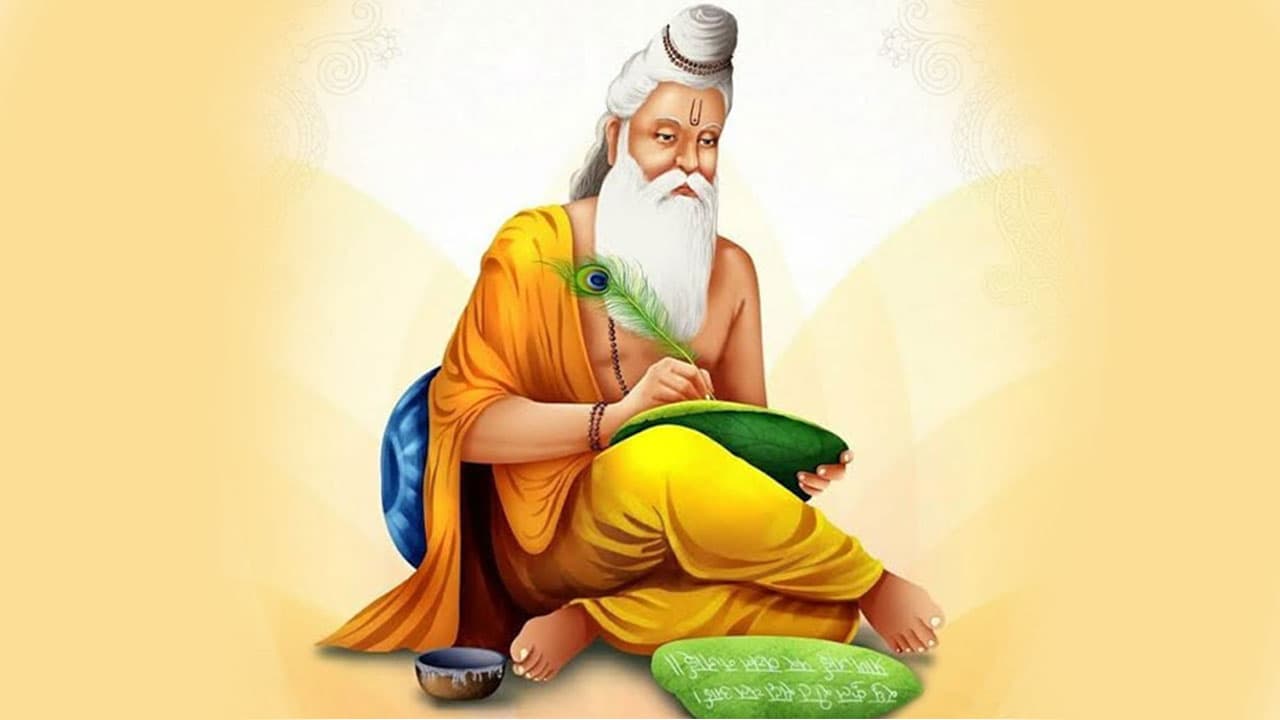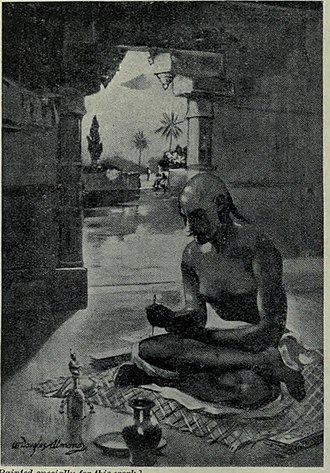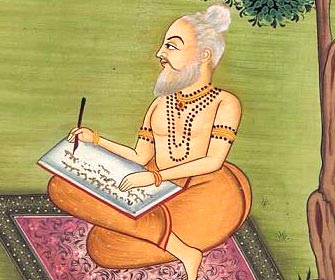Top of the Sand Stone Lintel: "A Fighting between Monkey King Vālin and Sugrīva" at Ku (Stupa) Phra Kona, Suwannabhumi District, Roi Et Province, Thailand. This photo was taken on June 17, 2022.
A01. Introduction
Rāmāyaṇa: The Timeless Epic of Duty, Love, and Redemption
First revision: Jul.22, 2022
Last change: Oct.17, 2024
Searched, Gathered, Rearranged, Translated, and Compiled by Apirak Kanchanakongkha.
1.
page 1
One of the most important literary works of ancient India, The Rāmāyaṇa रामायणम् ), is one of the two essential legends of Hinduism, known as Itihasas, the other being the Mahābhārata.
 Mahārishi Vālmīki wrote "Rāmāyaṇa," composed in Sanskrit with Devanagari Alphabets, source: time.astrosage.com, access date: July 25, 2022
Mahārishi Vālmīki wrote "Rāmāyaṇa," composed in Sanskrit with Devanagari Alphabets, source: time.astrosage.com, access date: July 25, 20221.
The word "Rāmāyaṇa" means Rāma's progress. Therefore, unlike Mahābhārata, Rāmāyaṇa is centered on Rāma, though people have often taken on other protagonists. Rāmāyaṇa is the story of the Solar dynasty (Surya vamsha or vamśa), while Mahābhārata is the story of the Lunar dynasty (Chandra vamsha or vamśa). The solar dynasty Ikṣvāku (इक्ष्वाकु) ended with Brihadbala (killed during the Kurukṣetra War), though the tale dragged on until Sumitra (ousted by Mahapadma Nanda). And have non-Sanskrit rendering like Rāmacharitmānas.
In Sanskrit, Rāma's story is found in Vālmīki Rāmāyaṇa, Adhyatma Rāmāyaṇa, Yogavasishtha Rāmāyaṇa, Mahābhārata's Vana Parva, Kālidāsa's Raghuvamsham, Bhavabhuti's Uttararamacharita, and Bhattikavya.
"My composition is devoid of all virtues; it has only one world-renowned virtue… in it is contained the great name of the Raghu lord."In praise of Rāma, Rāmacharitmānas by Tulsīdās.
 A Picture of Tulsīdās published in the Rāmcharitmānas, by Sri Ganga Publishers, Gai Ghat, Benaras, 1949, source: en.wikipedia.org, access date: Sep.21, 2022.
A Picture of Tulsīdās published in the Rāmcharitmānas, by Sri Ganga Publishers, Gai Ghat, Benaras, 1949, source: en.wikipedia.org, access date: Sep.21, 2022.
 Mahākavi Kālidāsa, source: en.wikipedia.org, access date: Jan.19, 2023.
Mahākavi Kālidāsa, source: en.wikipedia.org, access date: Jan.19, 2023.1.
page 2
INTRODUCTION:
THE STORY OF RĀMA
Rāmāyaṇa is one of the two most treasured epics composed in ancient India. Along with the Mahābhārata, it imbues the minds and hearts of millions of Hindus as a sacred text, a particular way of relating to the past, and as poetry, shaping (and, in turn, being shaped by) the community in crucial ways. Rāmāyaṇa narrates the life of Rāma, the legendary warrior prince of yodhyā, as he walks the path that destiny has paved for him. Vālmīki's Rāmāyaṇa gives us insights into the paradigm of righteousness, wisdom, and good conduct that is Rāma, the protagonist of this timeless tale.
"O Rāma! O one for whom valor is the truth!
Hear the truth. You are the god Nārāyaṇa...
the one who has vanquished his enemies in the
past and will in the future. You are without
decay. You are the brahman. O Raghava!
You are the truth in the middle and at the end."
BRAHMĀ REVEALS RĀMA'S TRUTH, SARGA (105), YUDDHAKĀṆḌA
1
The epic, traditionally ascribed to the Mahārishi Vālmīki, narrates the life of Rāma, a legendary prince of Ayodhya City in the Kingdom of Kosala. The epic follows his fourteen-year exile to the forest urged by his father, King Daśaratha, on the request of Rāma's stepmother Kaikeyī; his travels across forests in the Indian subcontinent with his wife Sītā and brother Lakṣmaṇa, the kidnapping of Sītā by Rāvaṇa - the king of Lañkā, that resulted in war; and Rāma's eventual return to Ayodhyā to be crowned king amidst jubilation and celebration.
The Rāmāyaṇa of Vālmīki
The Rāmāyaṇa, or the path or journey of Rāma as a narrative cycle, has captured the imagination of people in India and across the world for centuries. Devotees revere it, scholars study it, and storytellers and readers enjoy the text.
The Rāmāyaṇa, at its simplest, is about the exile of a righteous prince who performs deeds of spectacular valor. But, at its most exalted, it stands for the moment at which the Divine, in His play and grace, manifests Himself in the earthly realm, and a complex spiritual imaginary is part of this understanding.
The structure
While there are endless Rāmāyaṇas (The Rāmāyaṇa Universe), one of the earliest extant versions, also the most influential (though maybe not the best-known in its detail) within India, is Vālmīki's Rāmāyaṇa.
Composed in Sanskrit, it comprises seven parts called kāṇḍas, or chapters. These are the Bala Kāṇḍa (Childhood), Ayodhya Kāṇḍa (After the city of Ayodhya), Aranya Kāṇḍa (Forest), Kishkindha Kāṇḍa (After the Vanara realm, Kishkindha), Sundara Kāṇḍa (Beautiful), Yuddha Kāṇḍa (War), and Uttara Kāṇḍa (Concluding or Latter).
 Mahārishi (The great sage) Vālmīki, The Knowledgeable Seer: One of the Oldest existing versions, Vālmīki's Rāmāyaṇa is unique as it has the author also features as a crucial part of the story, source: 01. and sites.google.com, access date: Aug.07, 2022.
Mahārishi (The great sage) Vālmīki, The Knowledgeable Seer: One of the Oldest existing versions, Vālmīki's Rāmāyaṇa is unique as it has the author also features as a crucial part of the story, source: 01. and sites.google.com, access date: Aug.07, 2022.1.
page 3
The Rāmāyaṇa is one of the most significant ancient epics in world literature. It consists of nearly 24,000 verses (mostly set in the Shloka/Anustubh meter), divided into seven kāṇḍas.
1. Bala Kanda - The Bālakāṇḍa - Childhood.
2. Ayodhya Kanda - The Ayodhyakāṇḍa - After the city of Ayodhya.
3. Aranya Kanda - The Araṇyakāṇḍa - Forest.
4. Kishkindha Kanda - The Kiṣkindhakāṇḍa - After the Vanara realm, Kishkindha
5. Sundara Kanda - The Sundarakāṇḍa - Beautiful
6. Yuddha Kanda - The Yuddhakāṇḍa01. - War
7. Uttara Kanda - The Uttarakāṇḍa - Concluding or Latter.
---------------
01. Manuscripts of Northern recension generally entitle the sixth book, the Lañkākāṇḍa, "The Book of Lañkā."
1.
2.
Page 4
Each chapter, or kāṇḍa, is subdivided into subchapters called "sarga," meaning creation, in which this blog will be referred to as "sarga" (Sar-ra-ka).
The word "Rāmāyaṇa" means Rāma's progress. Or the adventure of Rāma, the Rāmāyaṇa differs from the Mahābhārata in that Rāmāyaṇa is centered on Rāma. Although some other characters are mentioned, the Rāmāyaṇa is the story of Surya vamśa, while the Mahābhārata is the story of the Chandra family (Chandra vamśa).
References:
01. from. "The Illustrated Ramayana: The Timeless Epic of Duty, Love, and Redemption," ISBN: 978-0-2414-7376-4, Penguin Random House, 2017, Printed and bound in China, www.dk.com.
02. from. "The Rāmāyaṇa of Vālmīki - THE COMPLETE ENGLISH TRANSLATION," translated by Robert P. Goldman, Sally J. Sutherland Goldman, Rosalind Lefeber, Sheldon I. Pollock, and Barend A. van Nooten, Revised and Edited by Robert P. Goldman และ Sally J. Sutherland Goldman, ISBN 978-0-6912-0686-8, 2021, Princeton University Press, Printed in the United States of America.
03. from. "THE VALMIKI RAMAYANA 1-3," translated by Bibek Debroy, ISBN 9780143428053, Penguin Random House India, 2017, printed at Replika Press Pvt. Ltd, Bhārata, www.penguin.co.in.
1.
2.
3.






